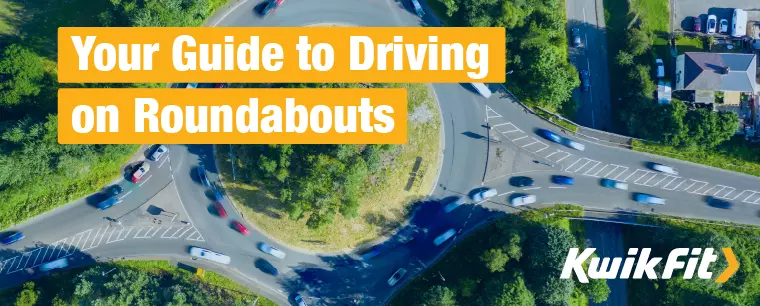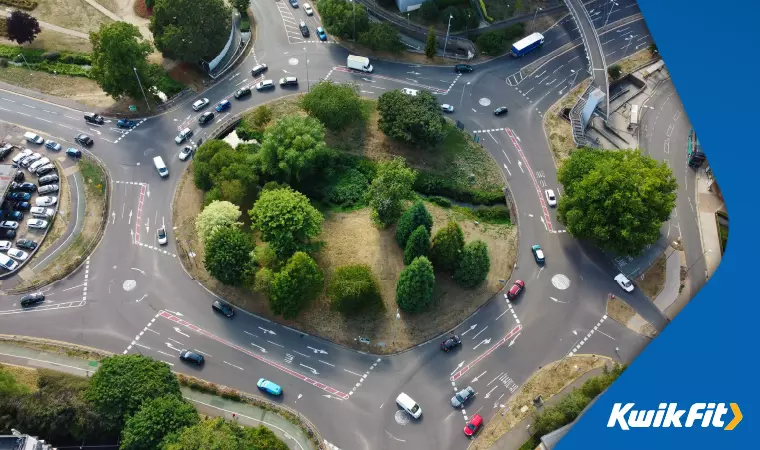Your Guide to Driving on Roundabouts
Jack Dreyer | Tuesday 14th March 2023 6:00pm

Did you know that there are more than 10,000 roundabouts in the UK?
Since their ‘invention’ in Letchworth Garden City back in 1907, roundabouts have been baffling drivers — new and experienced — for decades.
It’s a common fact that roundabouts are one of the harder aspects of driving. For learners especially, roundabouts offer the challenge of doing multiple things at once. Steering, braking, checking mirrors, maintaining a good speed, choosing the correct lane and staying in it, looking for a safe break in the traffic to pull away, and more.
If you’re learning to drive and want help with negotiating roundabouts for the first time — or want to brush up on the roundabout rules, read on.
Why do roundabouts exist?
Before roundabouts were introduced to Britain’s roads, there used to be plenty of traffic jams and traffic accidents at busy road intersections.
If two or more roads come to a meeting point, like in a crossroads, it can be difficult for drivers to know who has priority. Sometimes, at crossings or junctions, drivers can be tempted to run red lights or go even when they can’t fully see if it is clear.
In response to these challenges, roundabouts were built to try to keep traffic moving and flowing naturally without congestion or the risk of accidents. It’s easier as everyone travels in the same direction and turning right becomes far less hazardous. The ultimate aim was to reduce the time drivers spent waiting in traffic and to increase their safety.
The different types of roundabout
As anyone who has taken their theory test will know, there are multiple different types of roundabout and even some with different signage options. Let’s break them down.
Single-lane roundabouts
As the name would suggest, this type of roundabout simply has one lane and a central island. There are no traffic lights here.
Mini roundabouts
Mini roundabouts have their own sign — a blue one with arrows in a circle pattern. They are very similar to single-lane roundabouts. However, they don’t usually feature a central island. Instead, there is simply a raised section of the road in the middle, or a white circle painted onto the road.
Although it is tempting, you should not simply drive straight over the white paint as this roundabout is there for a reason. Besides, these roundabouts are quite tricky due to their small size. It is often quite difficult to steer and indicate at the same time when driving along this type of roundabout as it feels as though it’s over before it begins.
Access-controlled roundabouts
This type of roundabout usually involves a traffic light controlling the movement of traffic strategically. At this type of roundabout, it is less about your own judgement and more about waiting for the lights to change.
Magic roundabouts
Perhaps the most difficult type of roundabout is the magic roundabout. It isn’t that common but is feared by many for being so complex. It is made up of one central island that splits off into a series of mini roundabouts. As long as you stay in the right lane, check your mirrors, and signal to others, you’ll be fine.
Driving on roundabouts

Now that we know the reason for their existence and the different types, let’s get on to the difficult part: the driving. We’ll break down the roundabout process into a series of steps.
Approaching roundabouts
You’ll know when you’re approaching a roundabout as there will be road signs telling you so. There also may be a divide in the road into two lanes or a series of road markings encouraging you to slow down (either ‘SLOW’ written or a number of horizontal lines to make you aware of your speed).
Choosing the correct lane
When you notice a roundabout is coming up, make sure that you are in the right lane. Use the road signs to see which exit your destination needs you to come off at and pick the lane accordingly. As a general rule of thumb:
- If the exit is positioned before ‘12 o'clock’ on the roundabout sign, you’ll need the left-hand lane. This is usually for turning left or going straight on — but not always.
- If the exit is positioned after ‘12 o'clock’ on the roundabout sign, you’ll need the right-hand lane. This is usually for turning right — but not always.
However, it is also essential that you check the road markings as the road layout might not be what you expect. For example, even though you may be tempted to use the left hand lane to go straight across, the road markings may tell you that the left hand lane is for turning left into the first exit only!
Don’t panic if you get into the wrong lane, you can correct it by:
- Simply going round the roundabout again and coming off at the right exit
- Coming off the roundabout at the exit your lane wants you to leave at and driving back to try again
- If safe, get into the correct lane (indicating to show you are doing so).
Before you reach the roundabout, you should be indicating to other drivers which direction you are going.
- Turning left: Indicate left when approaching and continue to indicate when exiting
- Going straight on: Do not indicate when approaching but do indicate when exiting
- Turning right: Indicate right when approaching and continue indicating right until you get to your exit, where you should indicate left
Braking & checking
When approaching, you need to give yourself enough time to process what’s happening at the roundabout, so brake in good time (though not too early as you will have to accelerate again to reach the roundabout).
While you’re braking, check your mirrors. Be aware of who is behind you or if there is anyone who may overtake you. Perhaps there’s a cyclist on your inside, or a van in a hurry in the outside lane. It’s always good to check.
When it’s your turn to wait at the line, you’ll need to look to your right at the traffic coming around the roundabout towards you.
How do I know when to go at a roundabout?
This is the part learners and nervous drivers often struggle with; with cars queuing behind you, and cars coming round to meet you, it can feel quite pressured. It is common for learners to hesitate and start and stop at roundabouts as they don’t know when to commit to pulling away.
The lane to the right always has priority at roundabouts. So if someone is approaching from the right, you should always wait for them to pass. You want to avoid unnecessary hesitation as it often causes accidents – drivers behind assume that you are going and can rear-end you.
So, keep your cool and be smart. There are a series of clues that can make it easier for you to know when to go.
Do not go if…
- There’s a steady stream of traffic coming around the roundabout
- The car(s) coming towards you have their right indicators on, showing they are likely to keep coming
- The car in the lane next to you goes
- Your vision is blocked by a larger vehicle like a lorry or van in the right lane
- The traffic lights for your lane are red
Do go if…
- There is nothing coming
- The cars coming around the roundabout have their left indicators on and are slowing down, meaning they are turning off before they reach you (though be aware that sometimes people forget to turn off indicators)
- The traffic lights for your lane are green
Steering around the roundabout
Unless it is a single-lane roundabout, the chances are that there will be designated lanes. It is essential that you stay in your lane for safety and to avoid colliding with other road users.
If you are on the outside lane, try using bigger steers and aiming away from the centre of the roundabout to give the cars inside of you more space.
If you are on the inside, perhaps going right, check all around you, especially to your left to keep an eye on the cars on the outside of you. And, don’t worry about the central island, it is very rare that your car will come into contact with it, even if it does seem like a scary possibility.
Let’s look at the different routes you can take on a roundabout and talk you through the process of leaving the roundabout.
Exiting the roundabout
Turning left
This is usually the first exit. For this, you’ll need to be in the left hand lane. So, indicate left and check whether it is clear to go. Keep your indicator on and, when there’s a safe gap in the traffic, pull away and steer left.
Going left often feels like not using the roundabout at all as it is so quick. Once you have exited the roundabout safely, cancel your signal.
Continuing straight ahead
Usually this is done in the left hand lane but it can vary depending on how many exits there are and where the exits are positioned. You do not need to indicate when you are approaching the roundabout.
When it is safe to do so, pull away and stay in your lane until you have passed the exit before (usually the first exit). Then, check your mirrors (main and left to make sure there is no one to the left of you) and, while steering still, indicate left to let people know you are coming off. When it is clear, take the exit.
Turning right
This is the most complex manoeuvre out of the three. Typically, turning right involves the 3rd exit and almost always in the right-hand lane. Get yourself into the right lane and put your right indicator on to tell people where you’re going.
Then steer around the roundabout (until you pass the exit before yours). Then, check your rear view mirror, the left mirror, and stick your left indicator on to show other road users you are coming off.
Check your blind spot before moving into the left lane to exit — glancing over your left shoulder to make sure no one is in the way. And that’s it.
Stay safe on the road
Yes, roundabouts can be scary but we hope that after reading the guidance in this blog, you’ll feel more confident with changing lanes, knowing when to go, and even turning right.
If you have any questions about your vehicle and its condition, get in touch with the experts at your local Kwik Fit who would be happy to help.
Or, for more motoring advice, keep up with our blog.
Any facts, figures and prices shown in our blog articles are correct at time of publication.
Featured Articles
Is it Illegal to Drive With One Headlight?
Saturday 19th July 2025
Wondering if it’s illegal to drive with one headlight? Learn about the safety risks and penalties of illegal blown bulbs and why you should fix them promptly.
Air Con in EVs & Hybrids: Experts Answer Your Questions
Monday 30th June 2025
Does air con drain EV batteries? Can you use the air con while charging an electric car? Find out the answers to these questions & more from Kwik Fit’s experts.
Why Is Your Car Making a Noise? Fixes & Tips
Friday 13th June 2025
When your car starts making unexpected noises, it can certainly be quite disconcerting; it may be nothing to worry about, but here’s what you need to know.









